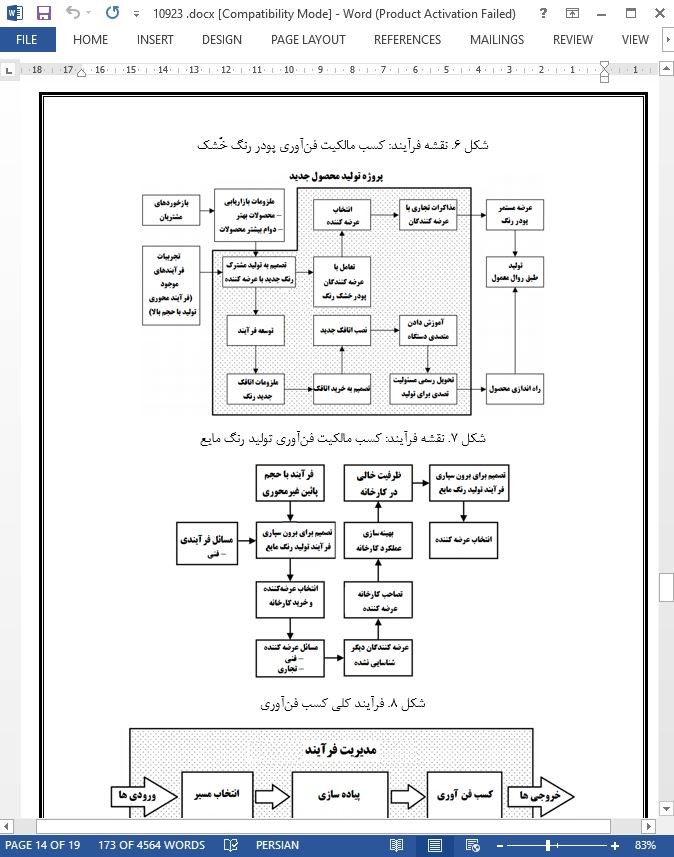
ارزیابی فرآیند مدیریت فناوری: مطالعه موردی
چکیده
مدیریت اثربخش فنآوری به عنوان یکی از منابع اصلی کسب مزیت رقابتی از اهمیت حیاتی برای بسیاری از سازمانها برخوردار است. فهم و برقراری ارتباط با فنآوری و یکپارچهسازی آن با راهبردهای بازاریابی، مالی، عملیاتها، و مدیریت منابع انسانی ضروری است. وقتی افزایش هزینه، سرعت، و پیچیدگی توسعه فنآوریها و همچنین کوتاه شدن چرخههای زندگی محصولات را در نظر میگیریم، این موضوع اهمیت خاصی پیدا میکند. ما یک مدل پنج فرآیندی را پیشنهاد دادهایم که چارچوبی را برای فهم فعالیتهای مرتبط با مدیریت فنآوری فراهم میکند. پنج فرآیند این مدل عبارتند از: شناسایی، انتخاب، مالکیت، بهرهبرداری، و حفاظت. بر مبنای این مدل، یک روش ارزیابی مدیریت فنآوری با استفاده از رویکرد ”اقدام پژوهی“ تدوین شده است. این مقاله مطالعه موردی صنعتی را ارائه میدهد که به توضیح اولین کاربرد کامل این روش در یک کسب و کار تولیدی با حجم تولید بالا پرداخته است. ارزیابی نتیجه بهکارگیری این روش بر اساس مزایای آن برای کسب و کارهای مشارکتکننده در تحقیق انجام شده و خود این روش در چارچوب اقدام پژوهی بهبود یافته است.
مقدمه
پیشینه
تاثیر فنآوری به عنوان یکی از منابع اصلی مزیت رقابتی برای صنایع تولیدی، بهطور گسترده مورد پذیرش مدیران و مجریان، دولتها، و صاحبنظران دانشگاهی قرار دارد. برای تحقق این مزیت رقابتی، فهم مدیریت کردن این فنآوریهای خاص و شیوههایی که سازمانها میتوانند به بهترین روش فنآوری را مدیریت کنند حیاتی است. با افزایش شتاب و پیچیدگیهای توسعه فنآوری این موضوعات اهمیت فزآیندهای یافتهاند.
کاربرد صنعتی
این روش ارزیابی (فال و همکاران، 1998؛ پروبرت و همکاران، 2000) در مراحل تولید و آزمایش، 13 بار و در 11 سازمان استفاده شده است (که یکی از این موارد در این مقاله شرح داده شد). از مرحله تولید برای تولید نمونههای اولیه قطعات و از مرحله آزمایش برای اعتبارسنجی یکپارچگی روش استفاده شده است. بخشهای صنعتی مربوطه عبارتند از: صنایع هوافضا، خودروسازی، الکترونیک، الکتریک، دریایی، ساخت و ساز، و داروسازی. سازمانهای مربوطه دارای فنآوریهای شامل فنآوریهای بالا، فنآوریهای متوسط، و فنآوریهای پائین بودهاند که تعداد کارکنان آنها از حدود 20 تا بیش از 5,000 بودهاند. همچنین، این روش در یک سازمان دانشگاهی مستقل (یعنی یک محیط خدماتی غیرتولیدی) نیز به کار گرفته شده است.
این روش به صورت مستقل و با موفقیت به کار گرفته شده است و اخیرا نتایج آن منتشر شده است (فاروق و همکاران، 2000). مطالب ارائه شده به منظور استفاده مدیران در صنایع مختلف طراحی شده است که شامل دانش ضمنی آنان در مراحل تدوین و کاربردی نمودن آن به شکل فرآیندها و روشهای اجرا میشود.
Abstract
The effective management of technology as a source of competitive advantage is of vital importance for many organisations. It is necessary to understand, communicate and integrate technology strategy with marketing, financial, operations and human resource strategies. This is of particular importance when one considers the increasing cost, pace and complexity of technology developments, combined with shortening product life cycles. A fiveprocess model provides a framework within which technology management activities can be understood: identification, selection, acquisition, exploitation and protection. Based on this model, a technology management assessment procedure has been developed, using an ``action research'' approach. This paper presents an industrial case study describing the first full application of the procedure within a high-volume manufacturing business. The impact of applying the procedure is assessed in terms of benefits to the participating business, together with improvements to the assessment procedure itself, in the context of the action research framework.
Introduction
Background
The impact of technology as a source of competitive advantage for manufacturing industries is widely accepted by practitioners, governments and academics. In order to realise this competitive advantage, it is vital to understand both the specific technologies, and the ways in which organisations can best manage technology. These issues are of increasing importance as the pace of technology development and its complexity increase.
Industrial application
The assessment procedure (Phaal et al., 1998; Probert et al., 2000) has been applied 13 times in a total of 11 organisations during the development and testing phases (one example of which is described in this paper). The development phase was used to prototype procedure components and the testing phase to validate the integrated procedure. Industry sectors included: aerospace, automotive, electronic, electrical, marine, construction and pharmaceutical, including high-, medium- and low-technology organisations, with staff numbers ranging from about 20 to more than 5,000. In addition, the procedure has been applied within an independent academic organisation (i.e. a non-manufacturing service-based environment).
The procedure has subsequently been successfully applied on an independent basis, and has been recently published (Farrukh et al., 2000). The guide is designed for use by managers in industry and includes much of the tacit knowledge generated during its development and application in the form of process and facilitation guidance.

چکیده
مقدمه
پیشینه
چارچوب فرآیند مدیریت فنآوری
چارچوب تحقیق
روش ارزیابی مدیریت فنآوری
مطالعه موردی
پیشینه سازمان
دیدگاه راهبردی
دیدگاه فرآیندی
بررسی فرآیندی
تشریح مطالب و نتیجهگیری
تجربه شرکت
مدل فرآیندی مدیریت فنآوری
انجام اصلاحات بر روی روش ارزیابی
چارچوب تحقیق
کاربرد صنعتی
Abstract
Introduction
Background
Technology management process framework
Research framework
Technology management process assessment
Case study
Company background
Strategic overview
Process overview
Process investigation
Discussion and conclusions
Company experience
Technology management process model
Modifications to assessment procedure
Research framework
Industrial application
- اصل مقاله انگلیسی با فرمت ورد (word) با قابلیت ویرایش
- ترجمه فارسی مقاله با فرمت ورد (word) با قابلیت ویرایش، بدون آرم سایت ای ترجمه
- ترجمه فارسی مقاله با فرمت pdf، بدون آرم سایت ای ترجمه
